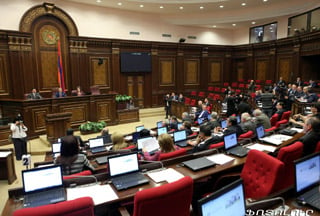
Going back to the Madrid Principles

Six years ago, in November 2007, the members of OSCE Minsk Group proposed a recommendation of Karabakh conflict settlement to the presidents of Armenia and Azerbaijan. This version of settlement is called “the Madrid Principles.”
The presidents of Armenia and Azerbaijan are going to meet again, and they will try to reach an agreement in the framework of the Madrid Principles. On June 24th, 2011, in Kazan the presidents of the two countries met due to the initiative of the Russian president, and at that time there was hope that there would be some improvement. However, the expected improvement was failed due to preconditions set by Azerbaijani president Ilham Aliyev. There was no official statement about additional preconditions developed by the Azerbaijani president, but non-official sources state that his main precondition was that 180 thousand Azerbaijanis had to be populated in Karabakh. The number of Azeri people that left from the Soviet Karabakh territory was 35,000, but now the Azerbaijani government thinks that their number has grown by five times. This huge inflow of Azeri people would change the ethnic balance in Karabakh, thus the referendum established by the Madrid Principles would be in favor of Azerbaijan. Azerbaijan’s additional preconditions failed the signing of an agreement. Now, in two and a half years, the parties are meeting again to reach an agreement. There is information that the US and Europe are for such an agreement, but Russia is for keeping the current status-quo, even though as a party to the OSCE Minsk Group it officially announces to support the settlement. Iran is against such peace agreement too as it does not want a longer border with Azerbaijan. Below are the Madrid Principles that are the ground for future agreement:
The Madrid Principles
- Withdrawal of Armenian forces from the regions surrounding Nagorno-Karabakh;
- Definition of an interim status for Nagorno-Karabakh Republic;
- Resettlement of these regions with Azerbaijani refugees;
- Provision of an overland link connecting Nagorno-Karabakh to Armenia through the Lachin corridor;
- Conduct of a referendum on the final status of Nagorno-Karabakh in some undefined, future date;
- Return of Azerbaijani refugees to the territory of Nagorno-Karabakh itself;
1) Karabakh’s final status shall be decided through plebiscite, meaning that the people of Karabakh shall be free to express their will. Timeframe and other details are subject to future negotiation. By saying “people of Karabakh” the parties shall mean the same proportion of people that used to live in Soviet Karabakh in 1988.
2) In an interim term, before the final definition of Karabakh’s status, its people shall have certain rights and privileges, which shall be clarified in the Peace Agreement according to the principles below:
-The people of Karabakh shall have a right to protect their own security and social and economic wellbeing, according to the international law.
-People of Karabakh shall have the right to elect officials for the interim term. Such officials shall implement legislative and executive governance, as well as establish courts. Such officials shall also be entitled to organize elections in the terms established by the Peace Agreement.
-Karabakh’s interim government shall have an observer’s status at OSCE sessions, where issues directly related to Karabakh will be discussed. They can become members of international organizations that do not require compulsory international recognition.
-Karabakh can receive financial support from international organizations and foreign countries.
3) Armenian powers leave the territories surrounding the former Soviet Karabakh. Armenian forces shall be taken out of Kelbajar region. International Transition Commission shall decide where to allocate limited armed forces till the signing of the Peace Agreement.
-Kelbajar region will be controlled by the International Interim Commission, which will include representatives from Armenia and Azerbaijan. The commission will implement international monitoring of that region. The population of Kelbajar will be encouraged to leave the region.
-Azeri people who have left that territory shall return to their place of living after the signing of Peace Agreement.
4) The overland link shall connect Armenia with Karabakh. Till the definition of the final status of Karabakh the overland link shall keep the same status as before the signing of the Peace Agreement. After the clarification of Karabakh’s final status, the status of the overland link will be defined according to the final status of Karabakh.
5) Based on the Peace Agreement all dislocated people shall have the right to return to their place of living after the UN Commissioner on Refugees announces that the places of their former residence are secure and safe. All people who return to their places of living, with no exception, shall enjoy human rights and fundamental freedoms. All parties shall provide their co-existence in order to ease the tension and improve the economic, political and social situation of the Armenian and Azeri people.
6) For the purpose of de-militarization and monitoring of security an international peacekeeping activity shall be envisaged till the enforcement of the Peace Agreement. Peace units shall comprise of troops. Provision of peace troops shall be done voluntarily. Any party has a right for veto over the other party.
The conclusion of the document writes that the Principles envisage the creation of 4 commissions. The first one shall develop the details of plebiscite, the second one shall define the “future status of the overland link,” and the third one should establish the full provision of the region of Kelbajar to Azerbaijan, and the fourth one shall discuss issues related to the implementation of main principles.
In Armenia generally there is no approach to these principles. A part of the political sector says that by signing such agreement Armenia will lose control of five regions surrounding Karabakh, and also agrees to give out one more region in the future (Kelbajar). Others believe this was the best solution Armenia has ever received. In Levon Ter-Petrosyan’s version of conflict settlement, which was according to phases, there was nothing about an interim term, and there was no referendum. The version that was supposed to be signed in Key West it was stipulated that the links of Lachin and Meghri would have the same status, which means that Armenia gives Meghri to Azerbaijan’s control. The positive side of Madrid principles is that as a result of those principles the international community will recognize Karabakh’s decision to join Armenia, which will be without the six regions.
If the presidents of Armenia and Azerbaijan sign the principles of Madrid now, it does not mean yet that those should be implemented immediately. Both in Armenia and Azerbaijan the presidents will be accused in treason and compromising national interests. President Sargsyan will be accused in giving the lands liberated with blood to Azerbaijan with a signature, and Aliyev will be accused in giving Karabakh to Armenians. There will be attempts to make revolution and by replacing presidents to void the document. This means that even if a document is signed today, it will be the beginning of a process but not the final solution.
By Avetis Babajanyan


















